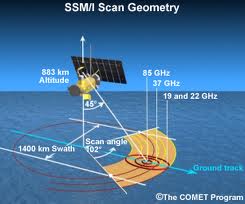The purpose of this project is to have the student
become familiar with the topic of microwave remote sensing of column water vapor (W)
and cloud liquid water path (L).
These quantities are derived starting with the radiative transfer equation for a
nonscattering atmosphere and arriving at the equations used by
Greenwald et al.
JGR 98, No.D10, pp 18471-18488, 1993. (You will need to get this reference!)
Results of this physical retrieval are to be compared to the results found
by the Frank Wentz's all-weather retrieval,
JGR 102, No. C4, pp 8703-8718, also available
here.
This is also sometimes called the "Remote Sensing Systems"
(RSS) retrieval.
The data to be used in this project will be described
in more detail shortly and will include SSM/I microwave brightness temperatures.
The SSM/I makes observations at four frequencies in the microwave region (19.35, 22.235, 37.0, 85.5 GHz).
Horizontal and vertical polarization measurements are made at 19.35, 37.0, and 85.5 GHz while
22.235 GHz has only vertical polarization measurements. Only the 19.35, 22.235, and 37.0 GHz data
are provided in gridded, average form in the file ssmi_jan90.txt


